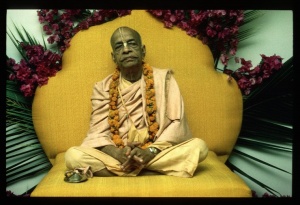CC Adi 7.122 (1975)

A.C. Bhaktivedanta Swami Prabhupada
TEXT 122
- pariṇāma-vāde īśvara hayena vikārī
- eta kahi' 'vivarta'-vāda sthāpanā ye kari
SYNONYMS
pariṇāma-vāde—by accepting the theory of transformation of energy; īśvara—the Supreme Lord; hayena—becomes; vikārī—transformed; eta kahi'-saying this; vivarta—illusion; vāda—theory; sthāpanā—establishing; ye—what; kari—do.
TRANSLATION
"According to Śaṅkarācārya, by accepting the theory of the transformation of the energy of the Lord, one creates an illusion by indirectly accepting that the Absolute Truth is transformed.
PURPORT
Śrīla Bhaktivinoda Ṭhākura comments that if one does not clearly understand the meaning of pariṇāma-vāda, or transformation of energy, one is sure to misunderstand the truth regarding this material cosmic manifestation and the living entities. In the Chāndogya Upaniṣad (6.8.4) it is said, san-mūlāḥ saumyemāḥ prajāḥ sad-āyatanāḥ sat-pratiṣṭhāḥ.The material world and the living entities are separate beings, and they are eternally true, not false. Śaṅkarācārya, however, unnecessarily fearing that by pariṇāma-vāda (transformation of energy) Brahman would be transformed (vikārī), has imagined both the material world and the living entities to be false and to have no individuality. By word jugglery he has tried to prove that the individual identities of the living entities and the material world are illusory, and he has cited the examples of mistaking a rope for a snake or an oyster shell for gold. Thus he has most abominably cheated people in general.
The example of misunderstanding a rope to be a snake is mentioned in the Māṇḍūkya Upaniṣad, but it is meant to explain the error of identifying the body with the soul. Since the soul is actually a spiritual particle, as confirmed in the Bhagavad-gītā (mamaivāṁśo jīva-loke), it is due to illusion (vivarta-vāda) that a human being, like an animal, identifies the body with the self. This is a proper example of vivarta, or illusion. The verse atattvato 'nyathā-buddhir vivarta ity udāhṛtaḥ describes such an illusion. To not know actual facts and thus to mistake one thing for another (as, for example, to accept the body as oneself) is called vivarta-vāda. Every conditioned living entity who considers the body to be the soul is deluded by this vivarta-vāda. One can be attacked by this vivarta-vāda philosophy when he forgets the inconceivable power of the omnipotent Personality of Godhead.
How the Supreme Personality of Godhead remains as He is, never changing, is explained in the Īśopaniṣad: pūrṇasya pūrṇam ādāya pūrṇam evāvaśiṣyate. God is complete. Even if a complete manifestation is taken away from Him, He continues to be complete. The material creation is manifested by the energy of the Lord, but He is still the same person. His form, entourage, qualities and so on never deteriorate. Śrīla Jīva Gosvāmī, in his Paramātma-sandarbha, comments regarding the vivarta-vāda as follows: "Under the spell of vivarta-vāda one imagines the separate entities, namely, the cosmic manifestation and the living entities, to be one with Brahman. This is due to complete ignorance regarding the actual fact. The Absolute Truth, or Parabrahman, is always one and always the same. He is completely free from all other conceptions of existence. He is completely free from false ego, for He is the full spiritual identity. It is absolutely impossible for Him to be subjected to ignorance and fall under the spell of a misconception (vivarta-vāda). The Absolute Truth is beyond our conception. One must admit that He has unblemished qualities that He does not share with every living entity. He is never tainted in the slightest degree by the flaws of ordinary living beings. Everyone must therefore understand the Absolute Truth to possess inconceivable potencies."